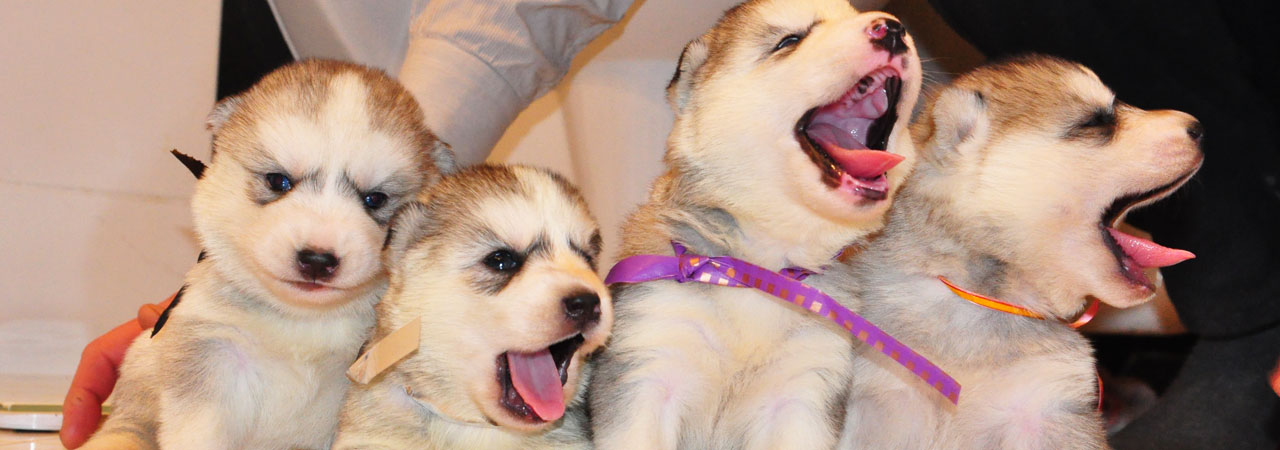
Siberian Husky standard and Characteristics
The official breed standard FCI
Coat
A sable Siberian Husky.
A Siberian Husky’s coat is thicker than that of most other dog breeds, comprising two layers: a dense undercoat and a longer topcoat of short, straight guard hairs.[2] It protects the dogs effectively against harsh Arctic winters, but the coat also reflects heat in the summer. It is able to withstand temperatures as low as −50 to −60 °C (−58 to −76 °F). The undercoat is often absent during shedding. Their thick coats require weekly grooming.
Siberian Huskies come in a variety of colours and patterns, usually with white paws and legs, facial markings, and tail tip. The most common coats are black and white, then less common copper-red and white, grey and white, pure white, and the rare “agouti” coat, though many individuals have blondish or piebald spotting. Striking masks, spectacles, and other facial markings occur in wide variety. Merle coat patterns are not allowed. The American Kennel Club allows all coat colors from black to pure white.
Eyes
A red/white colored Siberian Husky with heterochromia. Siberian Husky with two blue eyes. The American Kennel Club describes the Siberian Husky’s eyes as “an almond shape, moderately spaced and set slightly obliquely.”
The AKC breed standard is that eyes may be brown or blue; one of each or parti-colored are acceptable: (complete is heterochromia), and “parti-colored,” that is, half brown and half blue: (partial heterochromia). These eye-color combinations are considered acceptable by the American Kennel Club. The parti-color does not affect the vision of the dog.
Nose
Show-quality dogs are preferred to have neither pointed nor square noses. The nose is black in gray dogs, tan in black dogs, liver in copper-colored dogs, and may be light tan in white dogs. In some instances, Siberian Huskies can exhibit what is called “snow nose” or “winter nose.” This condition is called hypopigmentation in animals. “Snow nose” is acceptable in the show ring.
Tail
A Siberian Husky warming its nose with its tail.
Siberian Husky tails are heavily furred; these dogs will often curl up with their tails over faces and noses in order to provide additional warmth. As pictured, when curled up to sleep the Siberian Husky will cover its nose for warmth, often referred to as the “Siberian Swirl”. The tail should be expressive, held low when the dog is relaxed, and curved upward in a “sickle” shape when excited or interested in something. It should be symmetrical, and not curved or deviated to the side; the tail can curl enough to touch the back.
Size
The breed standard indicates that the males of the breed are ideally between 21 and 24 inches (53 and 61 cm) tall at the withers and weighing between 45 and 60 pounds (20 and 27 kg). Females are smaller, growing to between 20 to 22 inches (51 to 56 cm) tall at thewithers and weighing between 35 to 50 pounds (16 to 23 kg).
Behaviour
The Husky is known to howl rather than bark. Behavioural issues include a tendency to roam and to make escape attempts. They have been described as escape artists, which can include digging under, chewing through, or even jumping over fences.
The ASPCA classifies the breed as good with children. It also states they exhibit high energy indoors, have special exercise needs, may pursue cats, and may be destructive “without proper care.” A 6 ft (1.83 m) fence is recommended for this breed as a pet, although some have been known to overcome fences as high as 8 ft (2.44 m). Electric pet fencing may not be effective. They need the frequent companionship of people and other dogs, and their need to feel as part of a pack is very strong.
A fifteen-minute daily obedience training class has been shown to serve well for Siberian Huskies. Siberians need consistent training and do well with a positive reinforcement training program. They rank 45th in Stanley Coren’s The Intelligence of Dogs, being of average working/obedience intelligence. They tend to run because they were at first bred to be sled dogs. They were historically bred to be working and companion animals by the Chukchi people and should always be gentle in nature. The Chukchi people use Siberian huskies to look after their children.


